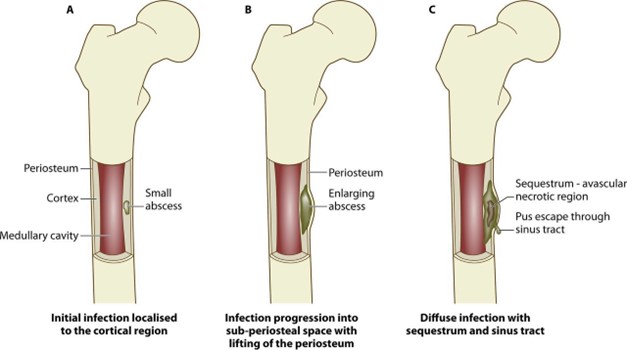A nurse is caring for a client who has acute osteomyelitis.
The client asks the nurse to explain how she developed the infection.
The nurse should respond that which of the following organisms is the most common cause?
Staphylococcus aureus.
Pseudomonas aeruginosa.
Streptococcus
Escherichia coli.
The Correct Answer is A
Staphylococcus aureus is the most common cause of acute osteomyelitis.
Osteomyelitis is an infection of the bone that can be caused by a variety of microorganisms, including bacteria, fungi, and mycobacteria.

Staphylococcus aureus is present in more than 50% of patients with osteomyelitis that results from contiguous spread from adjacent infected tissue or open wounds.
Choice B is not an answer because Pseudomonas aeruginosa is a less common cause of osteomyelitis and is more commonly seen in injection drug users.
Choice C is not an answer because Streptococcus B is not a common cause of osteomyelitis.
Choice D is not an answer because Escherichia coli is not a common cause of osteomyelitis.
Nursing Test Bank
Naxlex Comprehensive Predictor Exams
Related Questions
Correct Answer is B
Explanation
28 to 40 pounds (13 to 18 kilograms).
Women with a low BMI (under 18.5) should gain between 28 to 40 pounds (13 to 18 kilograms) throughout their pregnancy.
Choice A, 15 to 25 pounds (7 to 11 kilograms), is incorrect because it is the recommended weight gain for women who are overweight before pregnancy.
Choice C, 16 to 30 pounds (7.25 to 14 kilograms), is incorrect because it does not fall within the recommended weight gain range for women with a low BMI.
Choice D, 25 to 35 pounds (11 to 16 kilograms), is incorrect because it is the recommended weight gain for women who are at a healthy weight before pregnancy.
Correct Answer is B
Explanation
Treatment for Juvenile idiopathic arthritis (JIA) involves the use of various medications to decrease pain, improve function and minimize potential joint damage.
These medications can include Nonsteroidal anti-inflammatory drugs (NSAIDs) such as Ibuprofen, Disease-modifying antirheumatic drugs (DMARDs) such as Methotrexate, and other medications such as Indomethacin 1.
Choice A is incorrect because it only mentions one medication, Indomethacin.
Choice C is incorrect because it only mentions one medication, Methotrexate.
Choice D is incorrect because it only mentions one medication, Ibuprofen.
Whether you are a student looking to ace your exams or a practicing nurse seeking to enhance your expertise , our nursing education contents will empower you with the confidence and competence to make a difference in the lives of patients and become a respected leader in the healthcare field.
Visit Naxlex, invest in your future and unlock endless possibilities with our unparalleled nursing education contents today
Report Wrong Answer on the Current Question
Do you disagree with the answer? If yes, what is your expected answer? Explain.
Kindly be descriptive with the issue you are facing.
